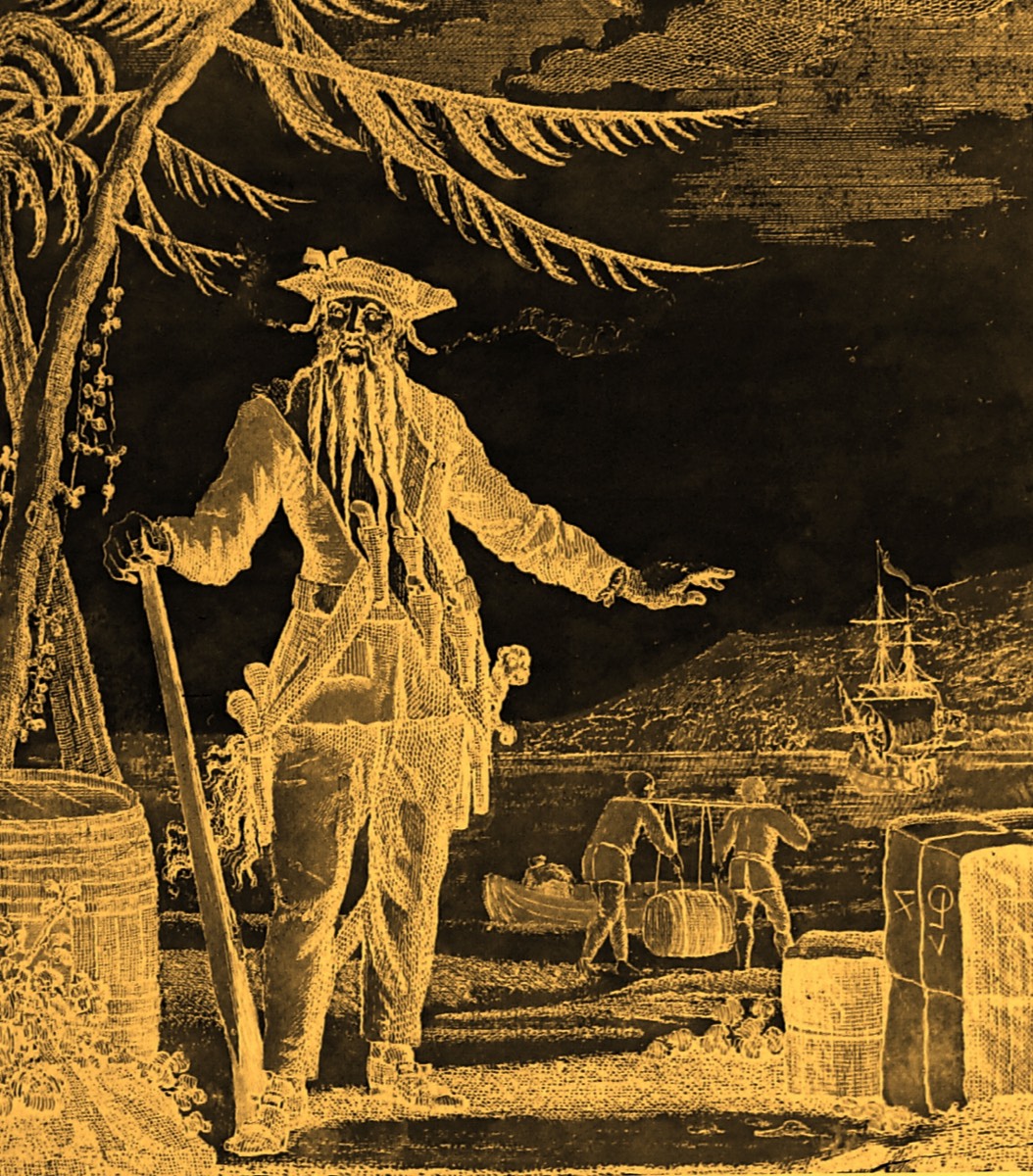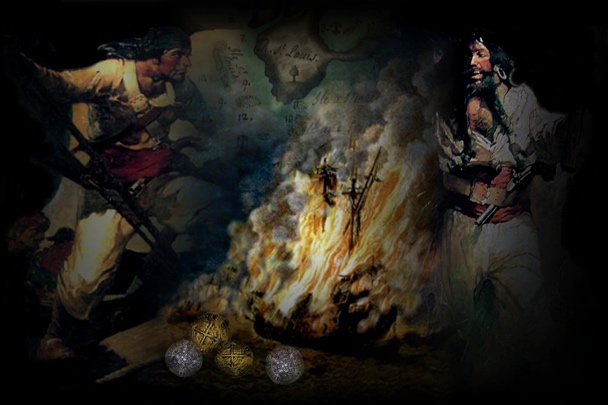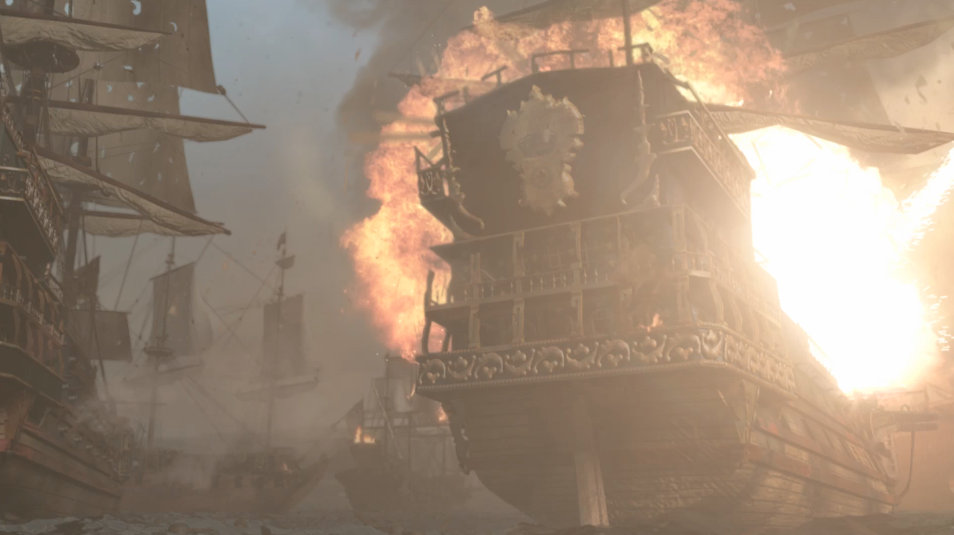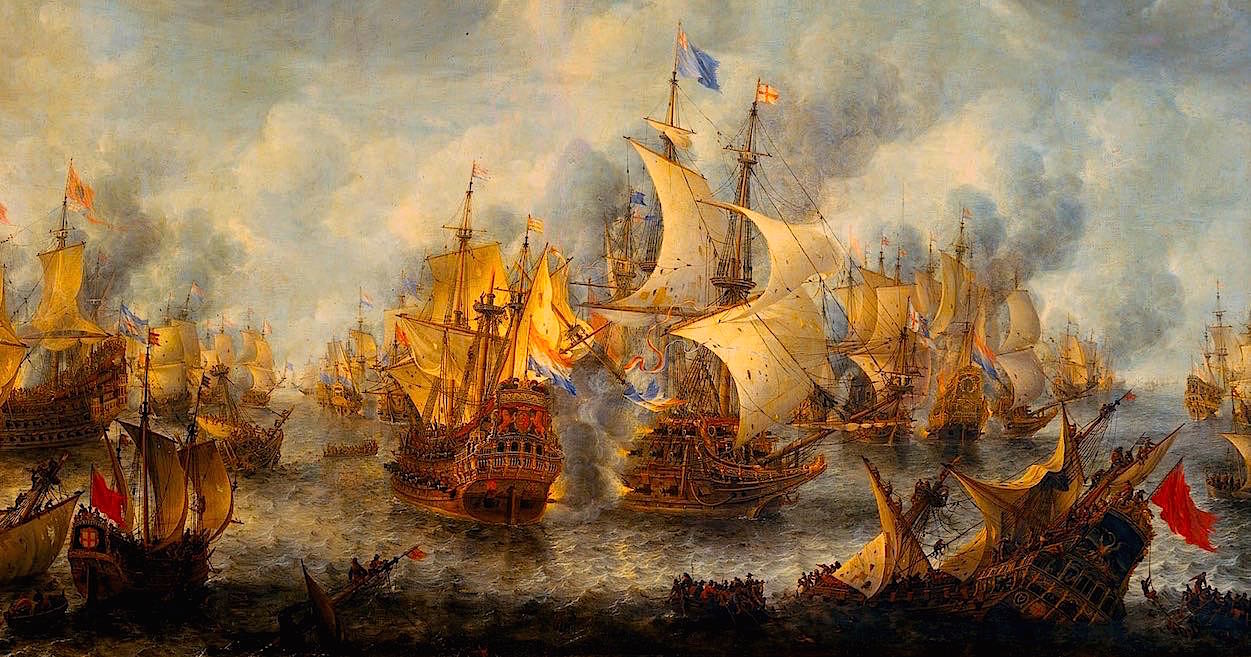OF PIRATES & BUCCANEERS

The word Buccaneer derives from “Boucan”. Carib Indians invented this wooden device to cook meat over fire by turning a handle. Many historians believe the original Buccaneers were not pirates but hunters of wild cattle and pig. This device, the “Boucan” gave rise to the name "Buccaneer". Trouble with the Spaniards led the Buccaneers to turn to piracy. Initially they seized only small boats, but later they attacked and plundered even the largest Spanish ships. Later on in the days of Captain Morgan, a Buccaneer was called a person who raided foreign ships on behalf of a Government or King. A letter of “Marque” (license to raid & plunder) made a pirate a Buccaneer.

A great deal has been written about the fabulous amount of booty taken by the buccaneers. These reports are greatly exaggerated. Such plunder as was taken was shared out promptly according to the article signed by every buccaneer. Theft and trickery was punished by death. Most buccaneers gambled and drunk their money away. Had any Captain attempted to bury the treasure he would not have survived for long.

To board another vessel the pirate ship would run alongside and fasten the opponent with grappling hooks. Naturally the pirate preferred the merchant ship to surrender to their threats or gun fire. If a merchant ship showed resistance the pirate would often hoist the “No Quarter” flag and butcher the entire crew.

The French pirate Emmanuel Wayne first used the Jolly Roger in 1700, when he engaged the “HMS Poole” of Santiago. The blood red “No Quarter” flag was equally dreaded. Early Jolly Rogers featured mostly some kind of skeleton holding a sword or pike, later they adapted to the cross bones.
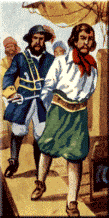
To be marooned was one of the penalties imposed on a pirate caught stealing from his fellows. Often the culprit was put ashore on a low island, which was covered by water at high tide. Such victims would be given a bottle of rum and a pistol with one bullet only. Very infrequently they were rescued.
FAMOUS PIRATES & BUCCANEERS
Sir Henry Morgan (Biography Link)
Born in 1635, a Welshman, he made his name as a privateer in the West Indies, proving his qualities by his attack on Panama. He became Governor of Jamaica and according to his enemies led a double life. Despite the accusations made against him he was an able and popular governor.
Born in 1635, a Welshman, he made his name as a privateer in the West Indies, proving his qualities by his attack on Panama. He became Governor of Jamaica and according to his enemies led a double life. Despite the accusations made against him he was an able and popular governor.
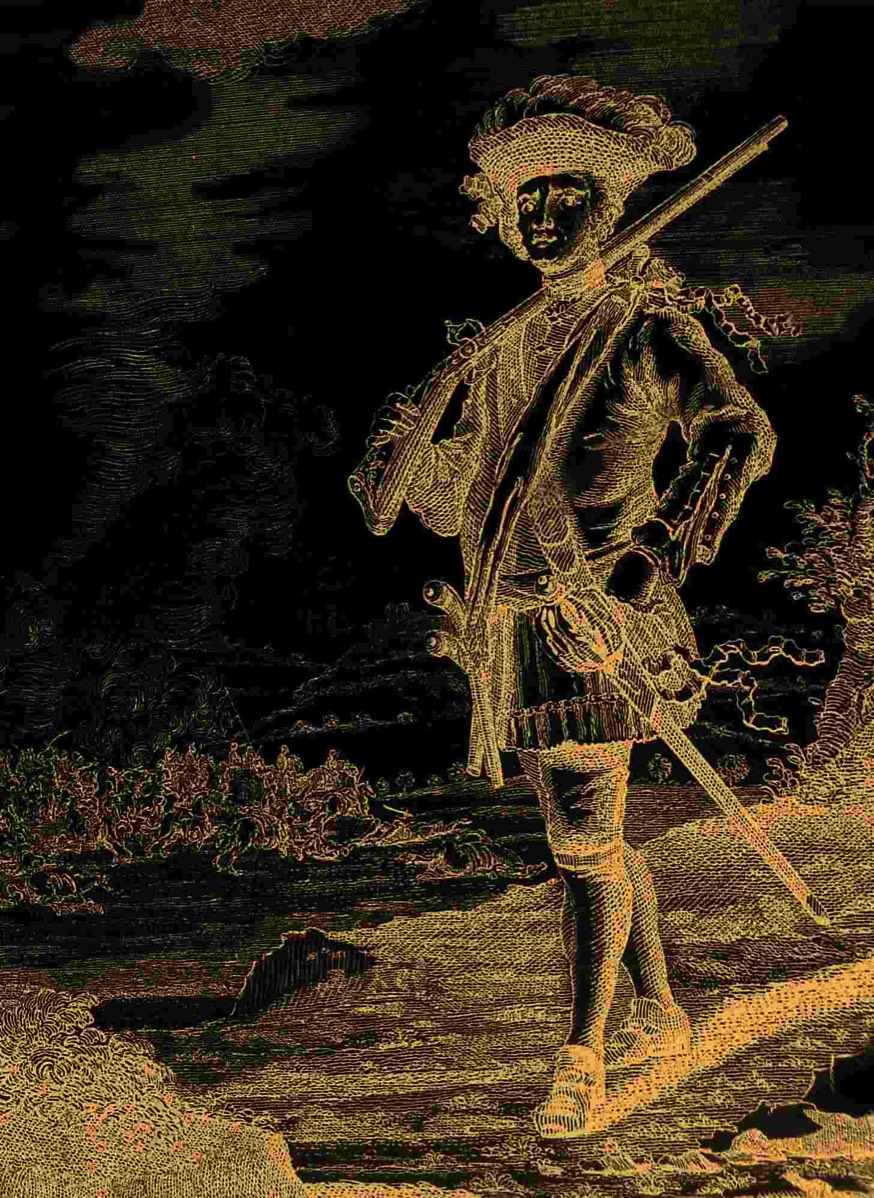
Anne Bonney
Anne was born in Ireland as the illegitimate child of a well known lawyer and his chamber maid. Because of this scandal Anne's father William Cormac had to leave England and he moved with his daughter to Charleston, South Carolina. From birth on Anne was cursed with a bad tember, one time stabbing a servant girl with a table knife. Still in her teens Anne married James Bonney a penniless idler, with him she moved to New Providence, Bahamas. Soon she fell in love with Calico Jack Rackam, a notorious pirate. Both stole a ship in Nassau harbour and started a new career-pirating. From this time on they kept on plundering coastal merchant men and fishing boats soon to become a major nuisance in the area. In October 1720 their carreer came to an uprupt halt as a British navy Sloop surprised them anchoring at Port Royal. There they were sentenced to death by hanging. Unlike her lover Calico Jack, Anne escaped the gallows as she was pregnant at the time and as such, by English Law, her death sentence has been suspended.
Anne was born in Ireland as the illegitimate child of a well known lawyer and his chamber maid. Because of this scandal Anne's father William Cormac had to leave England and he moved with his daughter to Charleston, South Carolina. From birth on Anne was cursed with a bad tember, one time stabbing a servant girl with a table knife. Still in her teens Anne married James Bonney a penniless idler, with him she moved to New Providence, Bahamas. Soon she fell in love with Calico Jack Rackam, a notorious pirate. Both stole a ship in Nassau harbour and started a new career-pirating. From this time on they kept on plundering coastal merchant men and fishing boats soon to become a major nuisance in the area. In October 1720 their carreer came to an uprupt halt as a British navy Sloop surprised them anchoring at Port Royal. There they were sentenced to death by hanging. Unlike her lover Calico Jack, Anne escaped the gallows as she was pregnant at the time and as such, by English Law, her death sentence has been suspended.
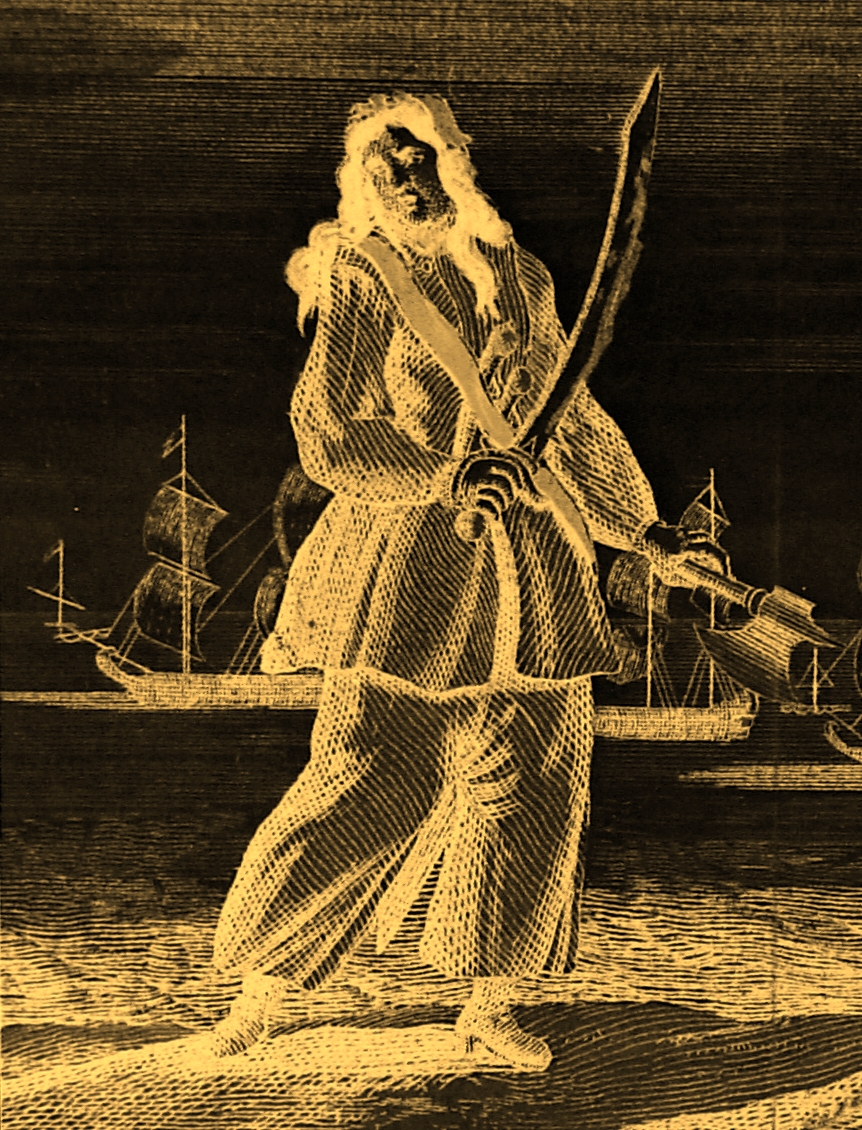
Edward England
Edward England started out as a legitimate sailor working on a merchant ship. Pirates captured his ship and took it to the Bahamas. There he chose to join their ranks avancing soon to a pirate captain. The british Navy under the orders of Governor Woodes Rogers drove him and other pirates in 1718 from the Islands. England first ventured to the west coast of Africa capturing several ships and sailed on to the Indian Ocean seeking more prizes there. In 1720, England captured the English ship "Cassandra" following a heavy sea battle. The Cassandra’s crew beached their ship and fled into the Madagascar jungle after the battle, only surrendering to the pirates after several days on the run. For their bravery he released the crew unharmed. Daniel Dafoe wroteabout him. "He had a great deal good nature and was always adversed to the ill usage prisoners received". But this unusual kindness also proofed to be his downfall. His crew revolted and left England alone off a little island off the coast of Madagascar. After much hardship he reached the main island where he lived as a beggar. He never managed to leave Madagascar and died there a poor man.
Edward England started out as a legitimate sailor working on a merchant ship. Pirates captured his ship and took it to the Bahamas. There he chose to join their ranks avancing soon to a pirate captain. The british Navy under the orders of Governor Woodes Rogers drove him and other pirates in 1718 from the Islands. England first ventured to the west coast of Africa capturing several ships and sailed on to the Indian Ocean seeking more prizes there. In 1720, England captured the English ship "Cassandra" following a heavy sea battle. The Cassandra’s crew beached their ship and fled into the Madagascar jungle after the battle, only surrendering to the pirates after several days on the run. For their bravery he released the crew unharmed. Daniel Dafoe wroteabout him. "He had a great deal good nature and was always adversed to the ill usage prisoners received". But this unusual kindness also proofed to be his downfall. His crew revolted and left England alone off a little island off the coast of Madagascar. After much hardship he reached the main island where he lived as a beggar. He never managed to leave Madagascar and died there a poor man.
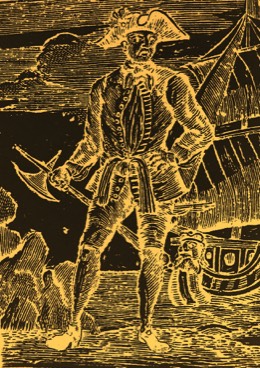
Henry Every
Henry Every started his pirate career in 1694 as a slave trader for the pirate. He served as the first mate on a privateer in the Bahamas, then led a mutiny against his captain when the captain was drunk. Every then sailed his ship to the west coast of Africa, then moved east to prey on shipping in the waters north of Madagascar. Every quickly captured four ships, three of them English. In 1695 he sailed into the Red Sea and lay in wait there for the annual treasure fleet that sailed from India to Arabia and back. Every attacked the fleet capturing two ships, the "Fateh Mohammed" and the "Gang-I-sawai". Both were the main treasure ships of the entire fleet, and the booty amounted to over 100 Million Dollars. With this unbelievable treasure Every and his crew sailed back to the Bahamas. From there on Henry Every was never seen nor heard of ever again. Unlike his fellow pirates he ended his days happy as a very wealthy mean and should be considered one of the most successful pirates ever.
Henry Every started his pirate career in 1694 as a slave trader for the pirate. He served as the first mate on a privateer in the Bahamas, then led a mutiny against his captain when the captain was drunk. Every then sailed his ship to the west coast of Africa, then moved east to prey on shipping in the waters north of Madagascar. Every quickly captured four ships, three of them English. In 1695 he sailed into the Red Sea and lay in wait there for the annual treasure fleet that sailed from India to Arabia and back. Every attacked the fleet capturing two ships, the "Fateh Mohammed" and the "Gang-I-sawai". Both were the main treasure ships of the entire fleet, and the booty amounted to over 100 Million Dollars. With this unbelievable treasure Every and his crew sailed back to the Bahamas. From there on Henry Every was never seen nor heard of ever again. Unlike his fellow pirates he ended his days happy as a very wealthy mean and should be considered one of the most successful pirates ever.
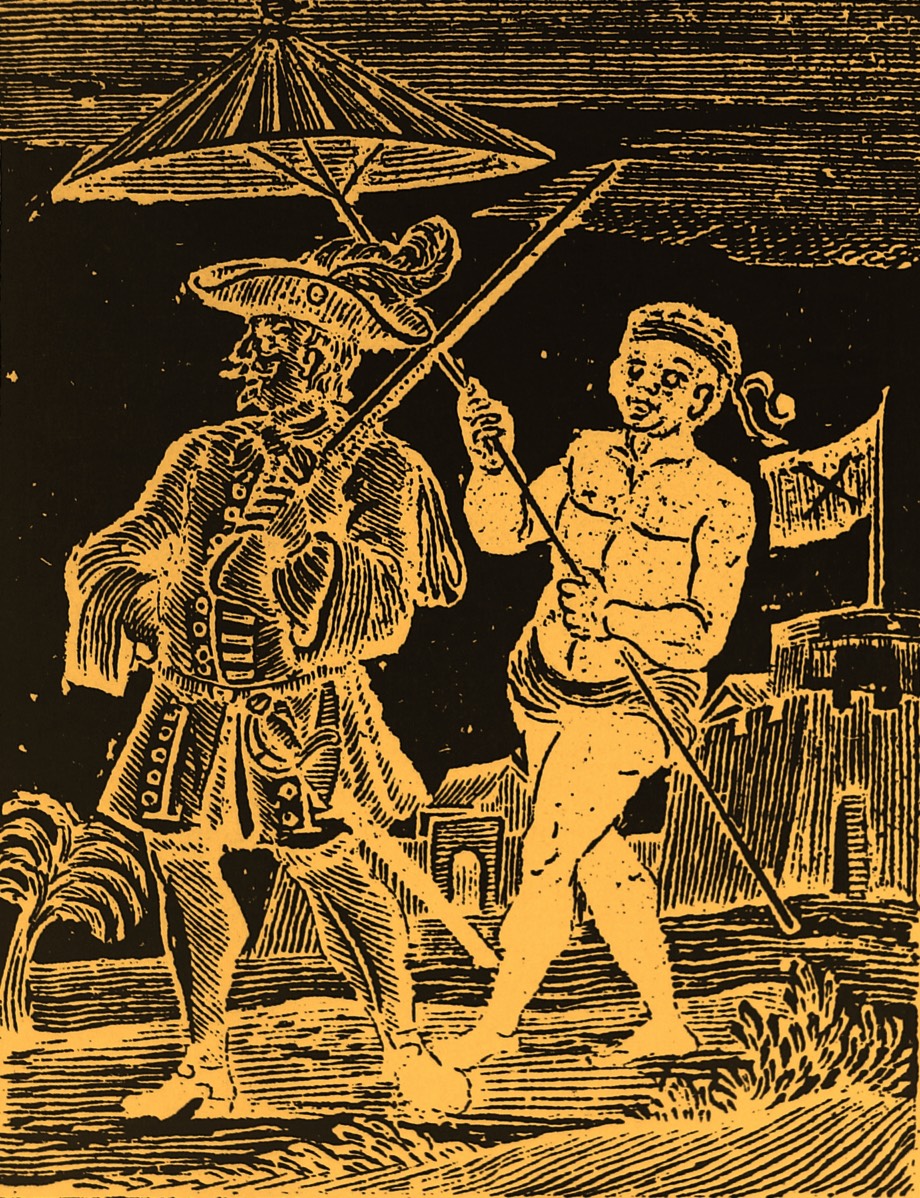
Thomas Tew
Thomas Tew began his career as a privateer in the Caribbean in 1690. Granted a Letter of Marque by the British government authorizing him to attack French shipping, he sailed to West Africa in 1690. However, a storm upset this plan and Tew and his crew turned from legitimate privateering to piracy. Tew quickly captured an Arab ship on the Red Sea, netting an impressive treasure worth up to 3,000 pounds for each man aboard his ship. Tew then sailed to his home of Newport, Rhode Island, where he was celebrated for his fortune and swashbuckling adventure tales. In 1694, Tew obtained a new Letter of Marque and sailed again for the Indian Ocean. By 1696 he was regarded as a notorious pirate, and Tew was specifically listed as one of the pirates that Captain Kidd was sent to hunt down. However, before Kidd could track him down, Tew sailed again to the Red Sea and attacked another Arab vessel but his one put up a fight, and Tew was killed by a cannon ball.
Thomas Tew began his career as a privateer in the Caribbean in 1690. Granted a Letter of Marque by the British government authorizing him to attack French shipping, he sailed to West Africa in 1690. However, a storm upset this plan and Tew and his crew turned from legitimate privateering to piracy. Tew quickly captured an Arab ship on the Red Sea, netting an impressive treasure worth up to 3,000 pounds for each man aboard his ship. Tew then sailed to his home of Newport, Rhode Island, where he was celebrated for his fortune and swashbuckling adventure tales. In 1694, Tew obtained a new Letter of Marque and sailed again for the Indian Ocean. By 1696 he was regarded as a notorious pirate, and Tew was specifically listed as one of the pirates that Captain Kidd was sent to hunt down. However, before Kidd could track him down, Tew sailed again to the Red Sea and attacked another Arab vessel but his one put up a fight, and Tew was killed by a cannon ball.
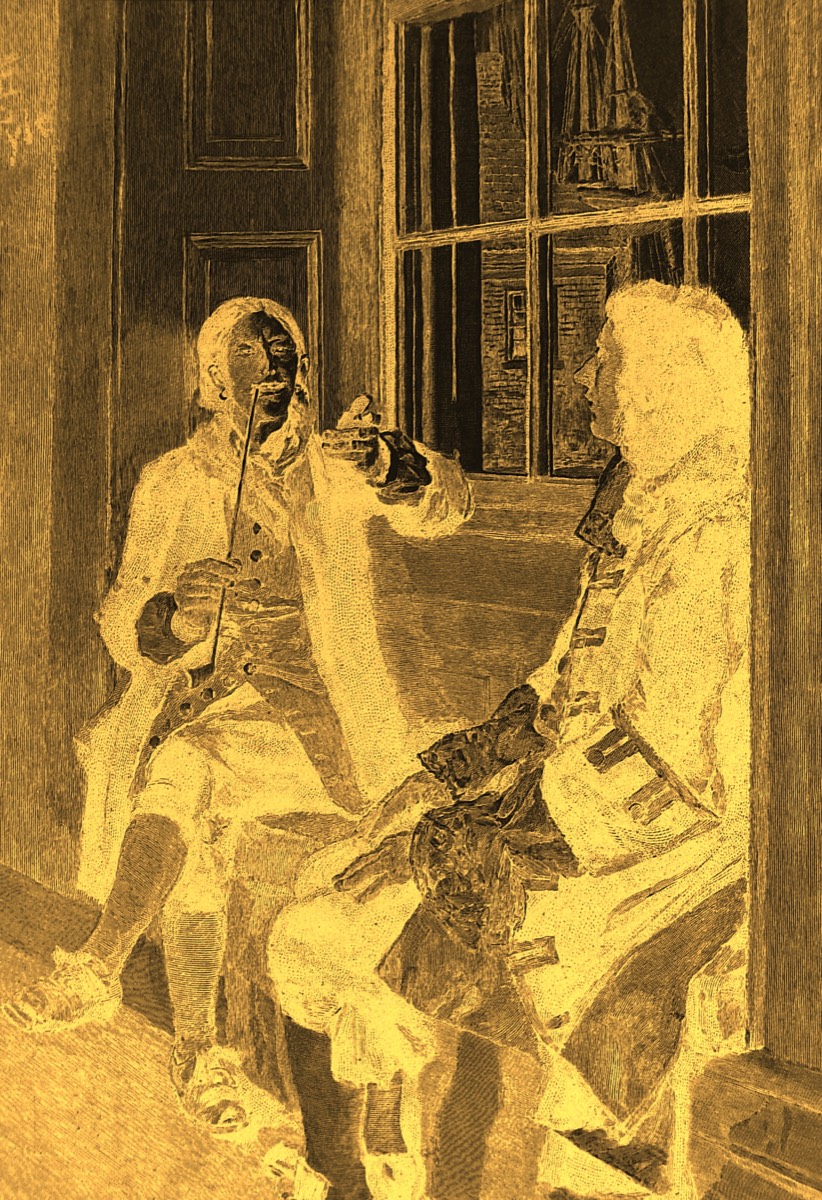
Bartholomew Roberts (Black Bart)
Bartholomew Roberts began his career as a mate on Howell Davis' ship. When Davis was killed, Roberts was elected captain, and began a very successful pirate career. Roberts began his hunting off the coast of Brazil, moving north to Newfoundland in 1720. Sailing back down the American coast, he reached the Caribbean in the summer of 1720, capturing 15 British, French and Dutch vessels. By the spring of 1721 Roberts left the West Indies behind, following a six-month spree during which he captured over 100 ships. Arriving at the West African coast, Roberts preyed on slave ships. In February 1722, British warships closed on Roberts' ships, capturing one and engaging Roberts' flagship "Royal Fortune" in battle. Roberts was killed instantly in a broadside of grapeshot, and his crew threw his body overboard to avoid the corpse being captured. The surviving pirates surrendered after a three hour battle. Most were hanged at Cape Coast Castle.
Bartholomew Roberts began his career as a mate on Howell Davis' ship. When Davis was killed, Roberts was elected captain, and began a very successful pirate career. Roberts began his hunting off the coast of Brazil, moving north to Newfoundland in 1720. Sailing back down the American coast, he reached the Caribbean in the summer of 1720, capturing 15 British, French and Dutch vessels. By the spring of 1721 Roberts left the West Indies behind, following a six-month spree during which he captured over 100 ships. Arriving at the West African coast, Roberts preyed on slave ships. In February 1722, British warships closed on Roberts' ships, capturing one and engaging Roberts' flagship "Royal Fortune" in battle. Roberts was killed instantly in a broadside of grapeshot, and his crew threw his body overboard to avoid the corpse being captured. The surviving pirates surrendered after a three hour battle. Most were hanged at Cape Coast Castle.
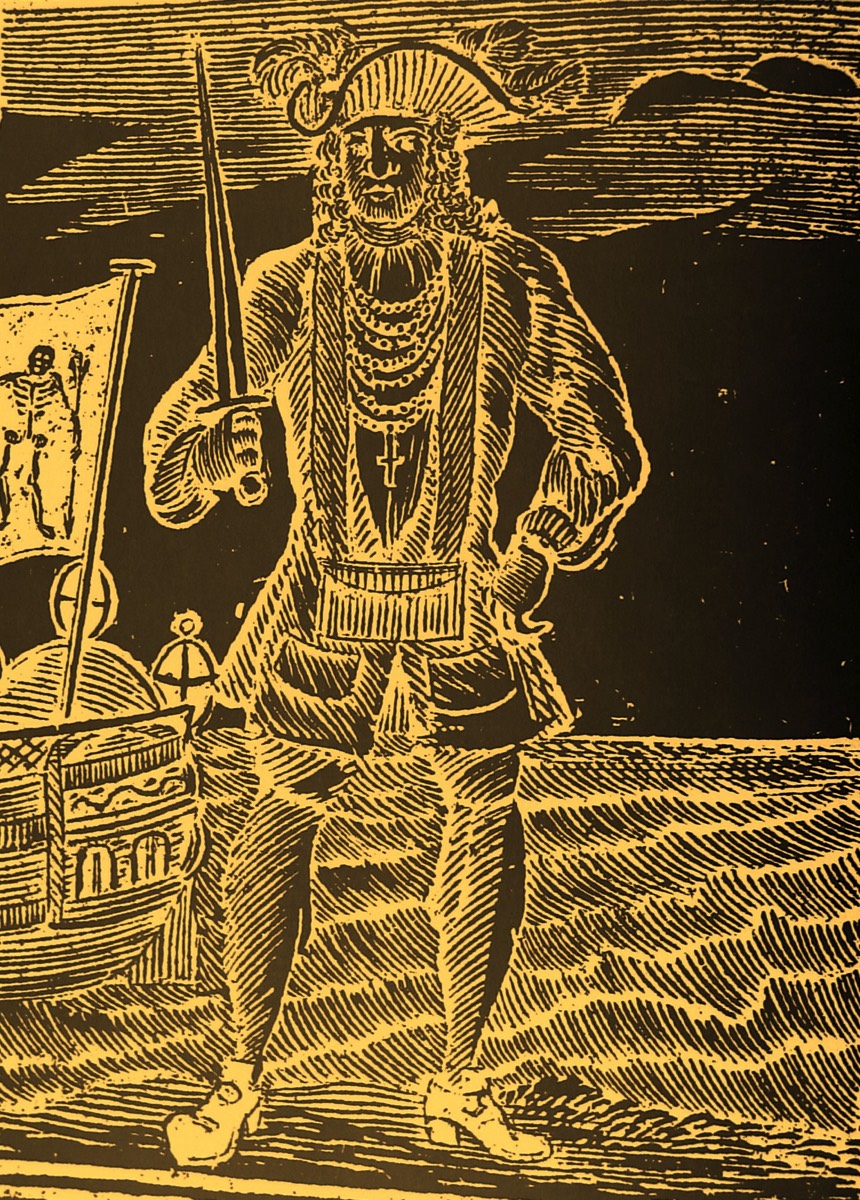
Charles Vane
Charles Vane began his pirate career in 1716, serving under Henry Jennings. When Jennings accepted a pardon and settled down, Vane went out on his own. When Woodes Rogers arrived as the new Governor of the Bahamas, Vane showed his contempt by setting a ship afire and sailing it toward Rodgers' ship. In this act of defiance Vane achieved his greatest notoriety. Vane then sailed north to the Carolinas, captured a few ships, but lost part of his crew due to a dispute. Vane then enjoyed a week-long party with Blackbeard before cruising on toward New York in late 1718. A dry spell in prizes stirred mutiny and in October 1718 Vane was deposed by his quartermaster, Calico Jack Rackham. Vane rebounded quickly, mustering a few loyal shipmates, and returned to the Caribbean. In February 1719, Vane's ship was caught in a hurricane off Cuba; only Vane and a single crewman survived. Upon being rescued, Vane was recognized and sent to Port Royal for trial. He was hanged for piracy in November 1720.
Charles Vane began his pirate career in 1716, serving under Henry Jennings. When Jennings accepted a pardon and settled down, Vane went out on his own. When Woodes Rogers arrived as the new Governor of the Bahamas, Vane showed his contempt by setting a ship afire and sailing it toward Rodgers' ship. In this act of defiance Vane achieved his greatest notoriety. Vane then sailed north to the Carolinas, captured a few ships, but lost part of his crew due to a dispute. Vane then enjoyed a week-long party with Blackbeard before cruising on toward New York in late 1718. A dry spell in prizes stirred mutiny and in October 1718 Vane was deposed by his quartermaster, Calico Jack Rackham. Vane rebounded quickly, mustering a few loyal shipmates, and returned to the Caribbean. In February 1719, Vane's ship was caught in a hurricane off Cuba; only Vane and a single crewman survived. Upon being rescued, Vane was recognized and sent to Port Royal for trial. He was hanged for piracy in November 1720.
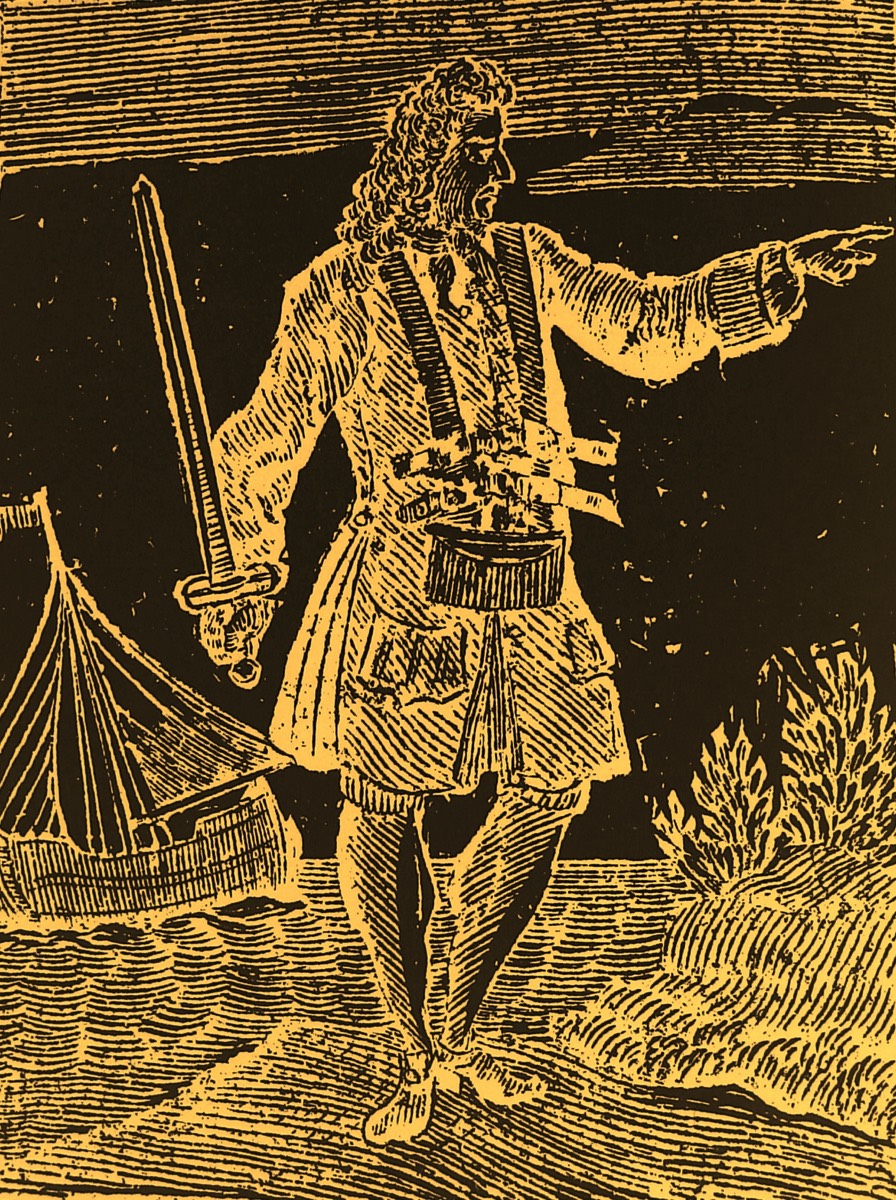
William Kidd
Captain Kidd went to sea in his youth and later settled in New York, where he married and owned property. In 1691 he was rewarded for his services against French privateers. While in London in 1695 he was commissioned by the "Earl of Bellomont", recently appointed governor of New York, as a privateer to defend English ships from pirates in the Red Sea and the Indian Ocean. In 1696, Kidd set sail for New York and from there to Madagascar. Disease, mutiny, and failure to take prizes apparently caused him to turn pirate. Returning in 1699 to the West Indies with his richest prize, the "Quedah Merchant", he learned of piracy charges against him. He sailed to New York to clear himself by claiming that the vessels he had attacked were lawful prizes. He was arrested and taken to London, where in 1701 he was tried on five charges of piracy and one of murder. The trial was complicated by the fact that four Whig peers who had backed him were politically embarrassed by his career. He was convicted and hanged. The barbaric cruelty and buried treasure of Captain Kidd are unsubstantiated bits of the legends about him.
Captain Kidd went to sea in his youth and later settled in New York, where he married and owned property. In 1691 he was rewarded for his services against French privateers. While in London in 1695 he was commissioned by the "Earl of Bellomont", recently appointed governor of New York, as a privateer to defend English ships from pirates in the Red Sea and the Indian Ocean. In 1696, Kidd set sail for New York and from there to Madagascar. Disease, mutiny, and failure to take prizes apparently caused him to turn pirate. Returning in 1699 to the West Indies with his richest prize, the "Quedah Merchant", he learned of piracy charges against him. He sailed to New York to clear himself by claiming that the vessels he had attacked were lawful prizes. He was arrested and taken to London, where in 1701 he was tried on five charges of piracy and one of murder. The trial was complicated by the fact that four Whig peers who had backed him were politically embarrassed by his career. He was convicted and hanged. The barbaric cruelty and buried treasure of Captain Kidd are unsubstantiated bits of the legends about him.
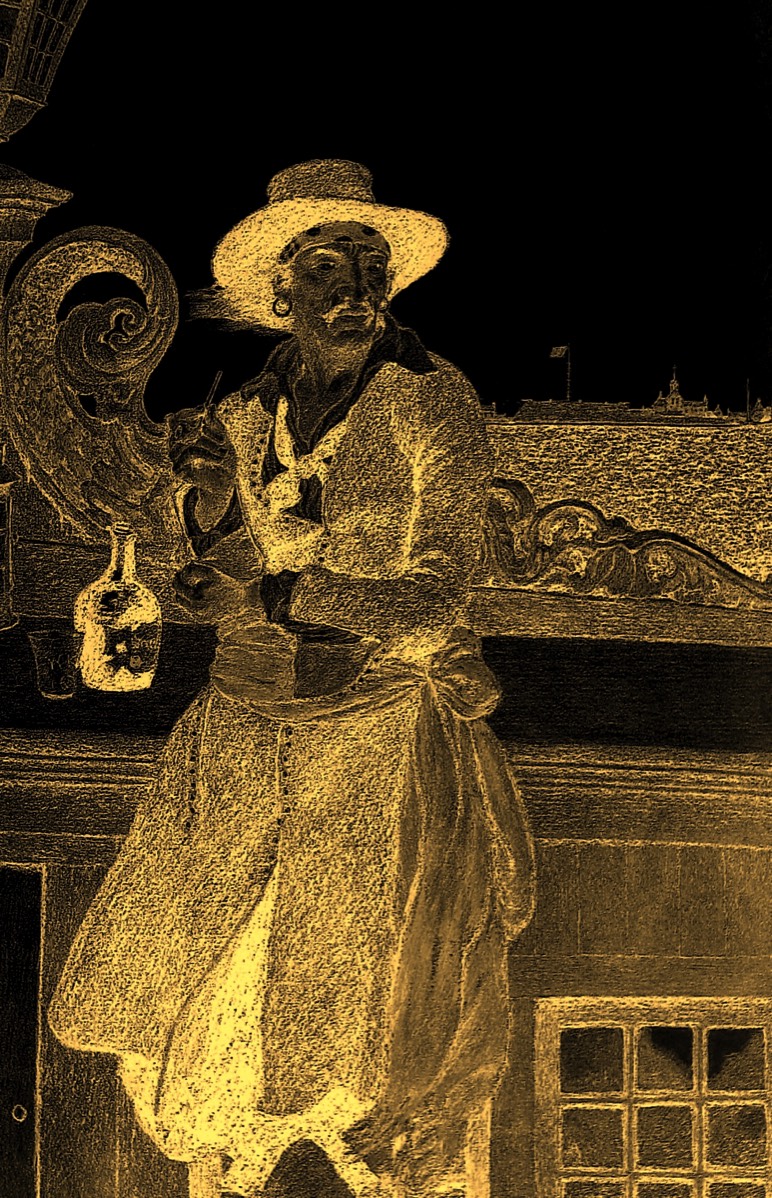
Blackbeard
Blackbeard was also known as Edward Teach or Thatch. He probably began as a privateer in the War of the Spanish Succession (1701-14), then turned pirate. In 1716-18 he preyed on shipping and coastal settlements of the West Indies and the Atlantic coast of North America, becoming notorious for cruelty. Blackbeard captured a French slave ship that he rearmed with 40 guns and renamed the "Queen Anne's Revenge". His initial base was in the Bahamas; he moved to the Carolinas after Governor Woodes Rogers ran all the pirates out of the Bahamas. The governor of North Carolina shared some of the booty, and provided Blackbeard some immunity from prosecution. For a period, Blackbeard sailed with Stede Bonnet, perhaps with Bonnet as his prisoner. In May 1718, Blackbeard blockaded the port of Charleston, capturing eight vessels. He returned to North Carolina but lost the Queen on a sandbar at Beaufort Inlet. In November 1718 the governor of Virginia sent two Royal Navy ships commanded by Lieutenant Robert Maynard to hunt Blackbeard down. Maynard chased Blackbeard down near Ocracoke Inlet, and Blackbeard's boarded Maynard's ship. A fierce hand-to-hand battle ensued and Blackbeard was killed. A charismatic leader, Blackbeard was also noted for his cruelty and larger-than-life image, enhanced by his wild beard braided with slow burning fuses.
Blackbeard was also known as Edward Teach or Thatch. He probably began as a privateer in the War of the Spanish Succession (1701-14), then turned pirate. In 1716-18 he preyed on shipping and coastal settlements of the West Indies and the Atlantic coast of North America, becoming notorious for cruelty. Blackbeard captured a French slave ship that he rearmed with 40 guns and renamed the "Queen Anne's Revenge". His initial base was in the Bahamas; he moved to the Carolinas after Governor Woodes Rogers ran all the pirates out of the Bahamas. The governor of North Carolina shared some of the booty, and provided Blackbeard some immunity from prosecution. For a period, Blackbeard sailed with Stede Bonnet, perhaps with Bonnet as his prisoner. In May 1718, Blackbeard blockaded the port of Charleston, capturing eight vessels. He returned to North Carolina but lost the Queen on a sandbar at Beaufort Inlet. In November 1718 the governor of Virginia sent two Royal Navy ships commanded by Lieutenant Robert Maynard to hunt Blackbeard down. Maynard chased Blackbeard down near Ocracoke Inlet, and Blackbeard's boarded Maynard's ship. A fierce hand-to-hand battle ensued and Blackbeard was killed. A charismatic leader, Blackbeard was also noted for his cruelty and larger-than-life image, enhanced by his wild beard braided with slow burning fuses.
